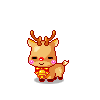This manga just reads like an exploitation film on paper. There's really no rhyme or reason why there's this level of violence, there just is. And the whole set-up for this manga seems out-of-place. Why did she need to go through all that weird shit just to end up working in a diner for criminals? Was it to showcase the level of weird shit that would be featured in this manga? Could've done it in a less slapdash way.
This is just my personal opinion as someone who's read and studied quite a bit on the French Revolution: I've read Innocent and adored it and have gone on to love this sequel to it, but I'm still a bit put off by the design choice of the revolutionaries like Marat, Saint Just, and Robespierre.
The author chose to keep to the standard fashion of the time when it came to Marie Antoinette and other nobility, giving them wigs and such, yet I don't seem to understand why Marat is drawn like a shuffling Phantom of the Opera knockoff. We have portraits and illustrations of him.
https://en.wikipedia.org/wiki/Jean-Paul_Marat
For me, it's one thing to do a nip and tuck here and there for a historical figure (Louis XVI sported a double chin and wasn't too handsome), but to completely change the look of a character--when we have evidence of what he looked like--to fit a completely anachronistic modern aesthetic for the sake of telegraphing their personalities and "Villain or Hero" status to us is kind of..I don't know, it puts me off just a bit.
Robespierre was reportedly a bit odd, though. According to eyewitness accounts, he wore tinted glasses and the same suit every day, something green and pink with pin stripes. He wore a powdered wig as well, as did most people at the time. In this manga, however, he looks like the lead singer of AFI in their early 2000s era, Davey Havok.
Again, this is all my opinion, but these design choices are what make me pause before I recommend to my professor that he take a look at this otherwise expertly-drawn, compelling and dramatic retelling of a very interesting part of French history.
Regarding the characters' designs, it's anachronism very well done (like in Samurai Champloo) so modern apperarance/objects are just symbolic devices to showcase the character's personality or to make parallellisms with modern society, which might help readers to understand better the story.
Besides, it's a homage to 70's shoujo manga, so the events/characters are greatly exaggerated in pretty much every way (not to mention some of them are fictional). I think the author also wanted to portray how frivolous and extravagant was the society back then, so the melodramatic shoujo-esque portrayal works pretty well.
Obviously opinions are opinions and it's okay if you don't like the designs, but if your professor approaches this manga expecting an accurate portrayal of everything, he or she is going to be disappointed. Damn, some of Marie's achievements are real life Charles Sanson achievements.
It's rare to see a female S that's as hardheaded and boorish as a male S without coming off as bitchy, but this author has managed to write Doona in that way, at least so far from what I've read. I'm not really into female doms but I'm not into asshole male doms, either, and her S nature is tied to how independent and brass she is, it's not a pathological need to make others hurt, but kind of like "You asshole, you're going to get a can of whoop ass!". The line between consent and sexual assault is still blurry, but this IS fiction, so it doesn't bother me.












Now Sangwoo is vulnerable and grasping for acceptance and Bum is there to awkwardly give it. I never would have guessed that things would end up like this but it happened so naturally and over time that it works.
Yes, i agree (⌒▽⌒)